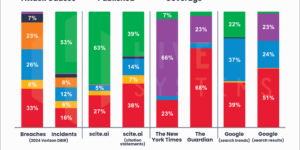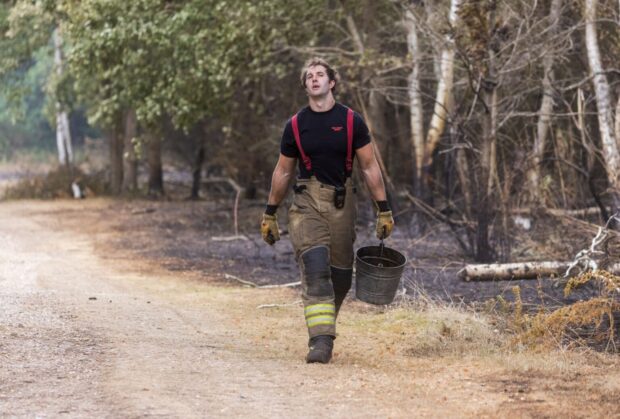The UK’s heat wave last month fueled so many blazes in London that the city’s fire service was busier than any day since Nazi attacks in World War II. More than 840 people may have died in England and Wales, according to a preliminary analysis. Now, a rapid scientific analysis of the event concludes that without climate change those conditions would have been “extremely unlikely.”
World Weather Attribution, the research team that conducted the study, looked at the weather in the southern half of the country on July 18-19, analyzing both peak temperatures and two-day averages. The analysis, released Thursday, found greenhouse gas pollution made the heat wave at least 10 times likelier and 4° Celsius (7.2° Fahrenheit) hotter than it would have been.
Coningsby, Lincolnshire, in east-central England, set a new UK heat record of 40.3°C (104.5°F) on July 19, breaking by 1.6°C the previous mark set in 2019. Forty-six UK weather stations recorded new highs. The heat wave also set a new mark for what scientists confusingly call high minimums, or basically hot nighttime temperatures. The country’s new night heat record is 25.8°C, almost 2°C hotter than the mark set in 1990.
The scientists at World Weather Attribution used two methods: a statistical approach looking at the temperature record and an analysis that combines historical data with multiple climate models. The team’s methodology is peer-reviewed. Having a verified approach allows team members to conduct a rapid analysis, which itself is not immediately peer-reviewed.
Heat waves are the most straightforward kind of extreme weather for scientists to study because they can look at temperature records without the additional complexity of atmospheric and water-system dynamics that give rise to cyclones, drought and wildfires. The effect of greenhouse gas pollution on temperature is so pronounced in general that WWA says it no longer needs to study every heat wave to know that the influence is there.
“[G]lobally, as a direct result of climate change, previously very rare heat is now just unusual,” they write. “While, in some cases, events now considered ‘extreme’ reach temperatures that were formerly all but impossible.”
WWA has become an authority on establishing links between global warming and extreme weather such as droughts and storms. Much of its work focuses on intense heat. The June 2021 heat wave over the western U.S.-Canada border would have been “virtually impossible” without climate change. Heat this spring in India and Pakistan was 30 times more likely because of greenhouse gas pollution. Siberian heat in the first half of 2020 was 600 times likelier.
Every heat wave emerges against a local backdrop of forces. But sometimes variability in WWA’s results can come from the limitations of available tools. These can explain why their conclusions about seemingly similar heat waves may differ. Models, for example, sometimes underestimate the scale of manmade warming so far. That means analyses that blend observations and models “are thus almost certainly too conservative,” the group wrote in a summary of its findings.
“It would have been four degrees cooler without climate change, but in the models, we only see that it’s two degrees cooler without climate change,” said Friederike Otto, senior lecturer in climate science at Imperial College London and WWA’s leader. “Which means that we cannot — with the tools we have available today — really quantify the role of climate change in a very satisfactory way.”
To accompany its primary analysis, the team looked at the temperature histories for three specific weather stations. For St. James Park, Cranwell, near where the new UK record high was set, the heat was a 1-in-500-years event. For Durham, which has temperature records that date back to 1880 and broke its local record by 4°C, the heat wave had a probability of occurring once every 1,500 years. Those calculations were made based on today’s climate — already 1.2°C hotter than before industrialization.
The UK has a jump on most of the world when it comes to preparing for heat extremes. First issued a year after the 2003 European heat wave, which was an impetus for the formal study of climate impacts on extreme weather, the Heatwave Plan for England was revised in 2012 and this month deployed to communicate health risks widely and clearly. The government issued its first color-coded heat alert, “amber,” which warns of temperatures so high that “fit and healthy” people, not only high-risk individuals, could be susceptible to illness or even death.
–With assistance from Kevin Simauchi.
Photograph: A firefighter carries a bucket of water to dampen the ground, following a major fire during a heat wave, on Dartford Heath near Dartford, UK, on July 20, 2022. Fires broke out across London and the city’s fire service declared a major incident, in the latest sign of how record-breaking heat caused chaos across the UK. Photo credit: Chris Ratcliffe/Bloomberg





















 Soft Market Ahead? The Role of Digital Transformation for E&S Insurers
Soft Market Ahead? The Role of Digital Transformation for E&S Insurers  Most Distracting Holiday Songs for Drivers Ranked
Most Distracting Holiday Songs for Drivers Ranked  Surviving the ‘Silver Tsunami’: Closing the Talent, Skills Gap in Underwriting
Surviving the ‘Silver Tsunami’: Closing the Talent, Skills Gap in Underwriting  Weak La Nina Expected in the Central Region of the U.S. This Winter: NWS
Weak La Nina Expected in the Central Region of the U.S. This Winter: NWS 


